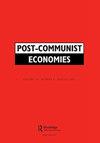一带一路倡议是否有利于中国设备出口?
IF 1.8
3区 经济学
Q2 ECONOMICS
引用次数: 0
摘要
摘要本文采用差异估计法考察了一带一路倡议对中国向相关国家出口装备的影响,考虑了不同国家政策冲击的不同时期。结果表明,该协议的签署使中国对该集团国家的设备出口增长了14.07%,这些国家主要集中在亚洲和非洲经济体,在电机、通用设备和特种设备的子行业,可能是通过中国跨国信贷的融资机制。简单地将一带一路倡议启动的年份定为政策冲击的统一时间可能会产生误导。本文章由计算机程序翻译,如有差异,请以英文原文为准。
Does one belt and one road initiative facilitate China‘s export of equipment?
ABSTRACT This article uses difference in difference estimation to examine the effect of the One Belt and One Road Initiative on China’s export of equipment to related countries, taking into consideration the different times of policy shock for different countries. The results show that signing the agreement induced a 14.07% increase of China’s export of equipment to the group of countries, which were focused on Asian and African economies, in sub-industries of electrical machinery, general equipment and special equipment, and probably through the financing mechanism of China’s transnational credit. Simply assigning the year when the One Belt and One Road Initiative is launched as the uniform time of policy shock may be misleading.
求助全文
通过发布文献求助,成功后即可免费获取论文全文。
去求助
来源期刊

Post-Communist Economies
ECONOMICS-
CiteScore
4.90
自引率
18.20%
发文量
21
期刊介绍:
Post-Communist Economies publishes key research and policy articles in the analysis of post-communist economies. The basic transformation in the past two decades through stabilisation, liberalisation and privatisation has been completed in virtually all of the former communist countries, but despite the dramatic changes that have taken place, the post-communist economies still form a clearly identifiable group, distinguished by the impact of the years of communist rule. Post-communist economies still present distinctive problems that make them a particular focus of research.
 求助内容:
求助内容: 应助结果提醒方式:
应助结果提醒方式:


